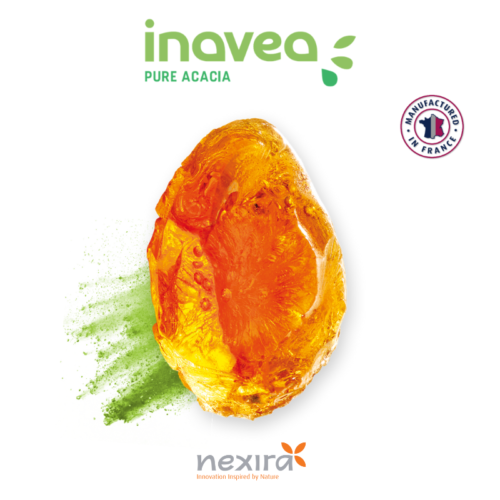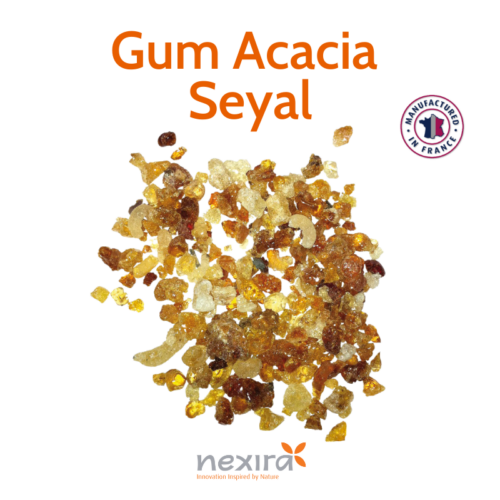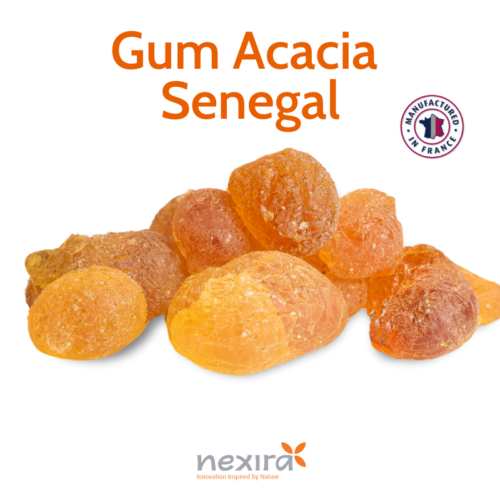Gum Arabic powder (Hashab gum): A natural food emulsifier and natural stabilizer for food processing
Gum Acacia (also called Gum Arabic) is made of the juice of a group of small acacia Senegal trees and shrubs, which grow predominantly around the warmer regions like gum belt, the Sahara in Sudan, Chad, Nigeria, Senegal and some parts of tropics and the Subtropics region. During the harvest season, trees are ‘tapped’ by making cuts in the trees. On the cuts the gum grows. After a few weeks the farmers get the gum from the tree. Crude of the grades are selected based on the type of Hand Picked Selected (HPS), Cleaned Gum, Siftings and Dust.
Gum Arabic is a pale white orange brown solid that breaks with glassy fracture. It is highly soluble in water and gives 50% of solution. It consists 95% of soluble fibre, which is a good source of neutral sugars like Rhamnose, Arabinose and Galactose. Gum Arabic is an excellent source of cationic components like calcium, magnesium, potassium and sodium.
Gum Arabic Powder from Acacia Senegal is the most preferred natural constituent for the production of high-quality soft candies. It gives the product with soft but firm, long lasting in the mouth, and provides a clean, non-sticky chewing.
Generally, this ingredient has various applications especially used in encapsulating flavours, preventing of sugar crystallisation, emulsifying the fat throughout the product and as lubricant/ binder in extruded snack cereals, partial oil replacer or water binder.
Applications of Foga Gum Arabic Powder:
| Industry type | Various end product applications |
| Confectionery | soft, chewy candy, gummy bears, marshmallows, coated candy |
| Beverages and flavours | flavour encapsulated |
| Dairy Products | Cheeses, condensed milk, pudding, dairy spread, whey products, milk powder, eggnog and other dairy-based drinks. |
| Processed Meats | hot dogs, sausages, luncheon meats, dried egg products, meaty soups, sauces and canned fish |
| Soya products | tofu and soymilk |
| Bakery Products | Extruded snacks, low fat cake and muffin mixes |
Gum arabic powder for confectionery
In the Confectionery industry, Gum Arabic is used to retard or prevent sugar crystallisation. It can be used to emulsify the fat and keep it evenly distributed throughout the product.
Beverages and flavours
Gum arabic can produce and stabilise emulsions and also excellent for encapsulation of flavours because gum Arabic has low viscosity, a bland flavour and protects against flavour oxidation.
Dairy products
Almost any dairy product can contain Gum Arabic powder. It is used in products like all types of cheeses, condensed milk, pudding, dairy spread, whey products, milk powder, eggnog and other dairy-based drinks.
Processed meats
Any meats that have been processed or have ingredients such as flavourings added to them are likely to contain Gum Acacia. This includes hot dogs, sausages, luncheon meats and canned fish. Any preserved meat or fish, as well as dried egg products and meaty soups and sauces also contain Gum Acacia.
Soya products
Products made with soybeans, such as tofu and soymilk, usually do not contain Gum Acacia. However, soy-based seasonings, such as soy sauce, are likely to use Gum Acacia as a preservative.
Bakery products
Gum Acacia applied as a lubricant and binder in extruded snack cereals, Gum Acacia provides adhesion of dry flavours in peanuts and similar products. In low fat cake and muffin mixes, Gum Acacia functions as a partial oil replacer as well as a moisture binder.
Pharmaceutical
The usage of Gum Acacia in pharmaceutical applications is based on its natural properties of emulsification, stabilisation, demulcent action, adhesiveness and binding action.
Gum Acacia is a 100% water-soluble non-starch polysaccharide (NSP) which is resistant to hydrolysis by the digestive enzymes of humans so delivers in excess of 85% total dietary fibre. Foods containing the requisite amounts specified in the pending EC Health Claims legislation can be labelled “contains a source of fibre”. Gum Acacia is approved for use in food (E414) with non-specified.






